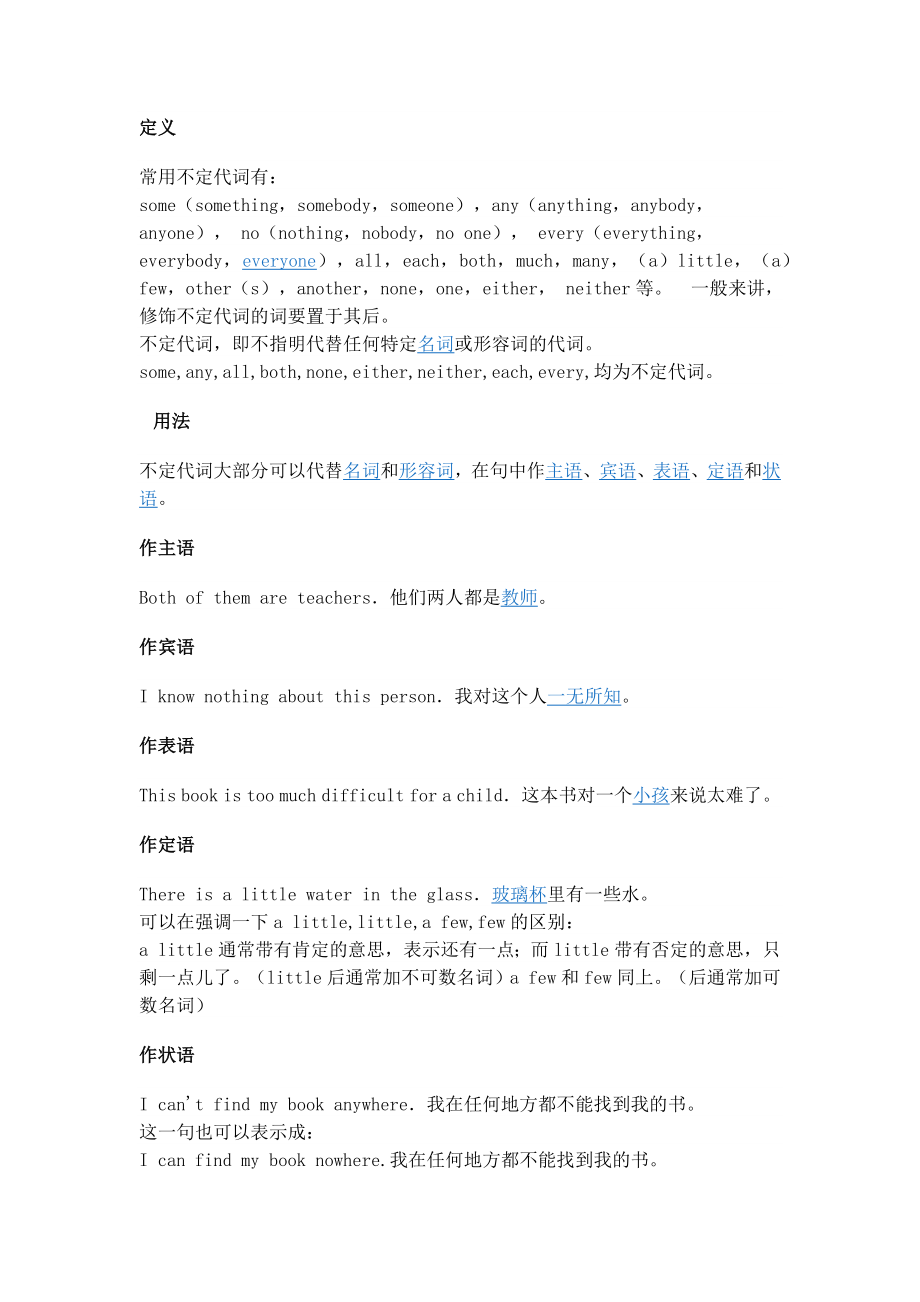 不定代词(包括复合不定代词)的用法及练习
不定代词(包括复合不定代词)的用法及练习



《不定代词(包括复合不定代词)的用法及练习》由会员分享,可在线阅读,更多相关《不定代词(包括复合不定代词)的用法及练习(7页珍藏版)》请在装配图网上搜索。
1、定义常用不定代词有:some(something,somebody,someone),any(anything,anybody,anyone), no(nothing,nobody,no one), every(everything,everybody,everyone),all,each,both,much,many,(a)little,(a)few,other(s),another,none,one,either, neither等。一般来讲,修饰不定代词的词要置于其后。不定代词,即不指明代替任何特定名词或形容词的代词。some,any,all,both,none,either,neith
2、er,each,every,均为不定代词。2用法不定代词大部分可以代替名词和形容词,在句中作主语、宾语、表语、定语和状语。作主语Both of them are teachers他们两人都是教师。作宾语I know nothing about this person我对这个人一无所知。作表语This book is too much difficult for a child这本书对一个小孩来说太难了。作定语There is a little water in the glass玻璃杯里有一些水。可以在强调一下a little,little,a few,few的区别:a little通常带有肯
3、定的意思,表示还有一点;而little带有否定的意思,只剩一点儿了。(little后通常加不可数名词)a few和few同上。(后通常加可数名词)作状语I cant find my book anywhere我在任何地方都不能找到我的书。这一句也可以表示成:I can find my book nowhere.我在任何地方都不能找到我的书。修饰不定代词的词,一般情况下要后置.3举例一般不定代词用法例子1some 一些,某些,某个不定代词some可以代替名词和形容词,常用在肯定句中作主语、宾语、定语等。作定语时,它可以修饰可数名词(单、复数皆可)和不可数名词。例如:some are doctor
4、s,some are nurses有些人是医生,有些人是护士。(作主语)2any一些,任何不定代词any可以代替名词和形容词,常用在否定句或疑问句中作主语、宾语、定语等。作定语时,它可以修饰可数名词(多为复数)和不可数名词。例如:there isnt any ink in my pen我的钢笔没有墨水。(作定语)不定代词any有时也可以用在肯定句中,表示任何的。例如:you may come at any time;ill be home the whole day你任何时候来都行,我整天都将呆在家里 。不定代词any也可以用作副词,做状语,表示程度。例如:is he any better t
5、oday?他今天好一点了吗?3all 全体,所有(指三者以上)不定代词all在句中可以作主语、宾语、表语、定语或同位语。它可以代表或修饰可数名词和不可数名词。代表或修饰可数名词时,指两个以上的人或物。作先行词时,引导词用that。例如:all were present at the meeting全都到会了。(作主语,代表可数名词)4both 全部,都不定代词both指两个人或事物。和all一样,可以用作主语、宾语、定语或同位语。例如:we invited both to come to our farm我们邀请两个人都来我们的农场?(作宾语)5none 无人或无不定代词none的含义和all
6、物相反,和no one,not any同义,但其用法相当于名词,在句子中一般作主语或宾语。它代替不可数名词作主语时,谓语动词用单数形式;代替可数名词作主语时,谓语动词用单、复数皆可。例如:none of the problems is /are easy to solve这些问题没有一个是容易解决的。(作主语, 代替可数名词)6either 两者之中的任何一个,这个或那个。不定代词 either 可以作主语、宾语和定语。例如:either of them will agree to this arrangent他们两人中会有人同意这样的安排的。(作主语)7neither 两者都不不定代词 ne
7、ither 是 either 的否定形式,可以作主语、宾语和定语。例如:neither is interesting两个都没有趣。(作主语)8each 每个,各自的不定代词each指每一个人或事物的个别情况,甚至指这些个别情况各不相同。它在句中可以作主语、宾语、定语和同位语。例如:she gave the children two apples each她给了每个小孩两个苹果。(作the children的同位语。)9every 每个,每一的,一切的不定代词every有全体的意思,和all的意义相近,但只能作定语。复合不定代词1. some, any, every, no都能和one, bod
8、y, thing一起构成代词,这些代词叫复合不定代词。它们基本含义为:指人 somebodysomeone 某人anybody 、anyone :任何人everybody 、everyone:每人nobody 、no one :没人指物 Something某物某事 anything任何事物 everything一切 nothing没东西2. 一般情况下,some构成的复合不定代词,其作用和some相同,用于肯定句;any构成的复合不定代词用于否定句或疑问句;no构成的复合不定代词表示否定含义,用于否定句。如: I have something to tell you. 我有事要告诉你。 He
9、didnt say anything at the meeting yesterday. 昨天在会上他没发言。 Everybody likes swimming. 每个人都喜欢游泳。 There is nothing wrong with your ears.你耳朵没毛病。3. something可用于提建议或请求的问句中,以及希望说话对方作出肯定回答的问句中。如:Would you like something to eat? 你要吃点东西吗?4. 复合不定代词在句子中作主语时,谓语动词一般用单数形式。如:Nobody knows his name. 没有人知道他的名字。5. 不定代词的定语
10、要后置。如:Is there anything important in todays newspaper? 今天的报纸上有什么重要新闻吗?一般的,不定代词(包括复合不定代词)在句子中,通常用第三人称单数形式6。复合不定代词的否定。1、“not every-”表示的是部分否定,意为“并非都,不都”。例如:Not everything will go well. 并非一切都会那么顺利。The teacher didnt call everyones name. 老师并没有点所有人的名。2、“not any-”和no-均表示全否定。例如:He listened, but heard nothing
11、.他听了听,但什么也没听到。= He listened, but didnt hear anything.You havent called anyone/anybody up, have you? 你没给谁打过电话,是吗?= You have called no one/nobody up, have you?1.不定式是英语动词的一种形式。它在许多情况下可省略to,它不同于汉语动词,汉语动词只有一种形式。如:我看书。她看书。但英语要说“看”必须根据主语的人称,动作发生的时间等确定其形式。如:1)I read a book. 2)She reads a book.1)句中的“read”是一般
12、现在时第一人称的动词定式。2)句中的“reads”是一般现在时第三人称单数的动词定式。I want to read a book./She wants to read a book.我想要看书。她想要看书。其中的“看”不易确定其形式。因为动作还未发生,因此称不定式。通俗的说,就是“不一定是什么形式”2.不定代词是不指明代替任何特定名词或形容词的代词,英语中不定代词有:some(something,somebody,someone),any(anything,anybody,anyone), no(nothing,nobody,no one), every(everything,everybod
13、y,everyone),all,each,both,much,many,(a)little,(a)few,other(s),another,none,one,either, neither等。1) 陈述部分的主语是I,疑问部分要用 arent I.Im as tall as your sister,arent I?2) 陈述部分的谓语是wish,疑问部分要用may +主语。I wish to have a word with you, may I?3) 陈述部分用 no, nothing, nobody, never, few, seldom, hardly, rarely, little等否
14、定含义的词时,疑问部分用肯定含义。The Swede made no answer, did he / she?Some plants never blown (开花), do they ?4) 含有ought to 的反意疑问句,陈述部分是肯定的,疑问部分用shouldnt / oughtnt +主语。He ought to know what to do, oughtnt he? / shouldnt he?5) 陈述部分有have to +v. (had to + v.),疑问部分常用dont +主语(didnt +主语)。We have to get there at eight to
15、morrow, dont we?6) 陈述部分的谓语是used to 时,疑问部分用didnt +主语或 usednt +主语。He used to take pictures there, didnt he? / usednt he?7) 陈述部分有had better + v. 疑问句部分用hadnt you?Youd better read it by yourself, hadnt you?8) 陈述部分有would rather +v.,疑问部分多用 wouldnt +主语。He would rather read it ten times than recite it, would
16、nt he?9) 陈述部分有Youd like to +v. 疑问部分用wouldnt +主语。Youd like to go with me, wouldnt you?10) 陈述部分有must 的疑问句,疑问部分根据实际情况而定。He must be a doctor, isnt he?You must have studied English for three years, havent you? / didnt you?He must have finished it yesterday, didnt he?11)感叹句中,疑问部分用be +主语。What colours, aren
17、t they?What a smell, isnt it?12) 陈述部分由neither nor, either or 连接的并列主语时,疑问部分根据其实际逻辑意义而定。Neither you nor I am engineer, are we?13) 陈述部分主语是指示代词或不定代词everything, that, nothing, this, 疑问部分主语用it。Everything is ready, isnt it?14) 陈述部分为主语从句或并列复合句,疑问部分有三种情况:a. 并列复合句疑问部分,谓语动词根据邻近从句的谓语而定。Mr. Smith had been to Bei
18、jing for several times, he should have been in China now, shouldnt he?b. 带有定语从句,宾语从句的主从复合句,疑问部分谓语根据主句的谓语而定:He is not the man who gave us a talk, is he?He said he wanted to visit Japan, didnt he?c. 上述部分主句谓语是think, believe, expect, suppose, imagine等引导的定语从句,疑问部分与宾语从句相对应构成反意疑问句。I dont think he is bright
19、, is he?We believe she can do it better, cant she?15) 陈述部分主语是不定代词everybody, anyone, somebody, nobody, no one等,疑问部分常用复数they,有时也用单数he。This is our new headmaster, isnt it?Those are Japanese, arent they?One should be ready to help others, shouldnt one?One cant be too careful, can you?Each of the student
20、s has a dictionary, hasnt he?Each of the students passed the examination, didnt they?None of his money is left, is it?None of his friends are interested, are they?None of his friends has come, has he?Something will have to be done about the price, wont it?Everybody is kind to you, arent they?No one
21、left here yesterday, did they?Someone turned that radio down, dont they?Neither side could win, could they?Everything that he says is false, isnt it?I am older than you, arent I / aint I?I am working now, aint I / am I not?I wish to see the movie now, may I?I wish I were you, may I?16) 带情态动词dare或nee
22、d的反意疑问句,疑问部分常用 need (dare ) +主语。We need not do it again, need we ?He dare not say so, dare you?当dare, need 为实义动词时,疑问部分用助动词do + 主语。She doesnt dare to go home alone, does she?17) 省去主语的祈使句的反意疑问句,疑问部分用will you。Dont do that again, will you?Go with me, will you / wont you ?注意: Lets 开头的祈使句,后用shall we?Let u
23、s 开头的祈使句,后用will you?Lets go and listen to the music, shall we?Let us wait for you in the reading-room, will you ?18) 陈述部分是there be结构的,疑问部分用there省略主语代词。There is something wrong with your watch, isnt there?There will not be any trouble, will there?19)否定前缀不能视为否定词,其反意疑问句仍用否定形式。It is impossible, isnt it?
24、He is not unkind to his classmates, is he?20) must在表推测时,根据其推测的情况来确定反意疑问句。He must be there now, isnt he?It must be going to rain tomorrow, wont it?快速记忆表陈述部分的谓语 疑问部分I arent IWish may +主语no,nothing,nobody,never,few, seldom, hardly, 肯定含义rarely, little等否定含义的词ought to(肯定的) shouldnt/ oughtnt +主语have to+v.(
25、had to+v.) dont +主语(didnt +主语)used to didnt +主语或 usednt +主语had better + v. hadnt youwould rather + v. wouldnt +主语youd like to + v. wouldnt +主语must 根据实际情况而定感叹句中 be +主语Neithernor,eitheror 连接的根 据其实际逻辑意义而定并列主语指示代词或不定代词everything,that, 主语用itnothing,this并列复合句 谓语根据邻近从句的谓语而定定语从句,宾语从句的主从复合句 根据主句的谓语而定think,believe,expect,suppose,imagine等引导 与宾语从句相对应的从句everybody,anyone,somebody,nobody,no one 复数they,单数he情态动词dare或need need (dare ) +主语dare, need 为实义动词do +主语省去主语的祈使句will you?Lets 开头的祈使句Shall we?Let us 开头的祈使句Will you?there be 相应的谓语动词+there(省略主语代词)否定前缀不能视为否定词 仍用否定形式must表推测 根据其推测的情况来确定反意疑问句1
- 温馨提示:
1: 本站所有资源如无特殊说明,都需要本地电脑安装OFFICE2007和PDF阅读器。图纸软件为CAD,CAXA,PROE,UG,SolidWorks等.压缩文件请下载最新的WinRAR软件解压。
2: 本站的文档不包含任何第三方提供的附件图纸等,如果需要附件,请联系上传者。文件的所有权益归上传用户所有。
3.本站RAR压缩包中若带图纸,网页内容里面会有图纸预览,若没有图纸预览就没有图纸。
4. 未经权益所有人同意不得将文件中的内容挪作商业或盈利用途。
5. 装配图网仅提供信息存储空间,仅对用户上传内容的表现方式做保护处理,对用户上传分享的文档内容本身不做任何修改或编辑,并不能对任何下载内容负责。
6. 下载文件中如有侵权或不适当内容,请与我们联系,我们立即纠正。
7. 本站不保证下载资源的准确性、安全性和完整性, 同时也不承担用户因使用这些下载资源对自己和他人造成任何形式的伤害或损失。
